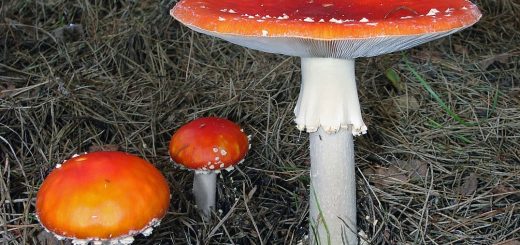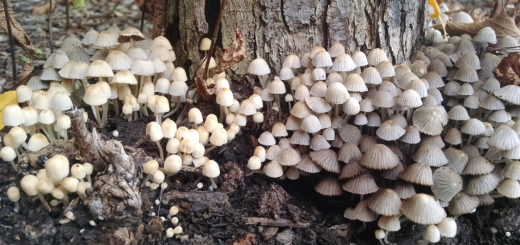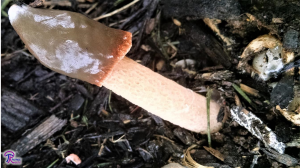#131: Class Ustilaginomycetes, Smut Fungi
These fungi are obligate plant pathogens with life cycles similar to the rust fungi. Thankfully, the smut fungi have much simpler life cycles: only one host and only two spore types. To make matters easier, smut fungi only infect flowering plants (angiosperms), with just five known exceptions out of the over 1,400 described species. Wondering about their common name? Although the word “smut” has come to mean “something obscene,” it originally meant “dirt” or “excrement.” Smut fungi produce copious amounts of powdery, black spores, which look like dirt en masse. “Smutted wheat,” therefore, is wheat that has had its seeds replaced by the dirt-like spores of a smut fungus.
True smut fungi belong to the phylum Basidiomycota and class Ustilaginomycetes. The Basidiomycota can be broken up into three main lineages: the Agaricomycotina (mushroom-forming fungi and relatives), the Pucciniomycotina (rusts and relatives), and the Ustilaginomycotina (smuts and relatives). FFF has previously treated rusts (FFF#130) and various mushrooms, so this post will help form a more complete picture of the phylum.
Fungi from two other lineages may be termed smut fungi, but they are not true smut fungi. The Microbotryales (anther smuts) were once grouped with the smut fungi, but are actually close relatives of the rust fungi. Species of Schroeteria also resemble smut fungi, but they belong in the phylum Ascomycota.
The life cycle of a smut is fairly simple. First, a basidiospore lands on a susceptible host and germinates. The basidiospore contains only one copy of each chromosome, so the fungus is haploid during this phase. Most smuts germinate to form single-celled yeasts, but some form filamentous hyphae. In both cases, the fungus grows saprobically. While none of the websites I consulted would specify what it is that smuts decompose during this stage in their life cycle, I suspect most of them break down the simple sugars found on leaf surfaces. Both yeasts and hyphae can be spread to other plants during this phase, but different mechanisms are involved. Yeasts can be transferred from one plant to another by animals, be flung into the air by wind or splashing raindrops and then be blown to a new plant, or be transferred directly when two plants bump into each other. Hyphae are less motile, so they produce asexual spores (conidia) that are dispersed by the wind.
When a haploid yeast or hypha encounters another haploid individual with a compatible mating type, the two cells fuse together to become dikaryotic. Every cell now one nucleus from each parent. As with most fungi, these nuclei remain separate in every cell except those going through meiosis. Once the smut enters its dikaryotic phase, it becomes pathogenic. Both yeasts and hyphae halt their previous activities and send out specialized hyphae that penetrate the plant’s tissues and cell walls.
Smuts tightly regulate their interaction with their host. Infection structures called “haustoria” both absorb nutrients from their host cell and deposit hundreds of different compounds into their host cell. Many of these compounds are designed to block the plant’s defenses, which allows the fungus to grow through the plant unchecked. Thanks to this process, many smuts are able to spread their hyphae throughout the entire plant (“systemic infection”). Despite suffering from a systemic infection, plants often remain symptomless until the smut is ready to reproduce.
Most smuts form reproductive structures on their host plant’s seeds or flowers, but these can appear on any part of the plant. Smuts force their host to do most of the work when preparing to reproduce. By releasing molecules that make its host’s cells grow larger and divide quicker, the fungus stimulates the production of tumor-like structures called “sori.” As a result of the increased cell growth, the plant sends more resources to these areas and ends up feeding the fungus instead of growing or producing seeds. Fungal hyphae form large masses in the sori and begin producing teliospores. The teliospores are thick-walled and can survive long periods of adverse conditions, such as winter or drought. The blackish, powdery teliospores are released when the sori break down.
When a teliospore is ready to germinate (usually after overwintering), the two haploid nuclei fuse to create a single nucleus with two copies of each chromosome (one copy from each parent). This “dikaryotic” nucleus then goes through meiosis to produce four haploid nuclei, each with one set of recombined chromosomes. Each haploid nucleus is then sent into a developing basidiospore. These basidiospores are then dispersed by the wind to new plant hosts.
Smuts can also spread to new plants through their original host’s seeds. Because a smut infection is systemic, smut hyphae are often found in any seeds that the beleaguered plant manages to produce. Consequently, the plants produced from those seeds will already be infected with the smut fungus.
Smut fungi include a few commercially important plant pathogens. Most of these infect wheat, cereal grains, and corn. Modern fungicides have been effective at treating infection, so smuts are generally not worrisome. In bad years, however, smuts can reduce production by a significant amount, resulting in damage worth millions of dollars. Ustilago myadis, which attacks corn, is probably the most useful smut fungus. It is very easy to grow in a laboratory setting, so mycologists use it as a model organism for studying plant pathogens. In Mexico, the large sori produced by U. myadis on ears of corn are considered a delicacy. Called “Huitlacoche,” these diseased ears are quite tasty and are more valuable than heathy corn!
See Further:
http://tolweb.org/Ustilaginomycotina/20530
http://www.botany.hawaii.edu/faculty/wong/BOT135/Lect08.htm
http://archive.bio.ed.ac.uk/jdeacon/FungalBiology/grassmut.htm









![#011: Characteristics of Kingdom Fungi [Archived]](https://www.fungusfactfriday.com/wp-content/themes/hueman/assets/front/img/thumb-small-empty.png)

